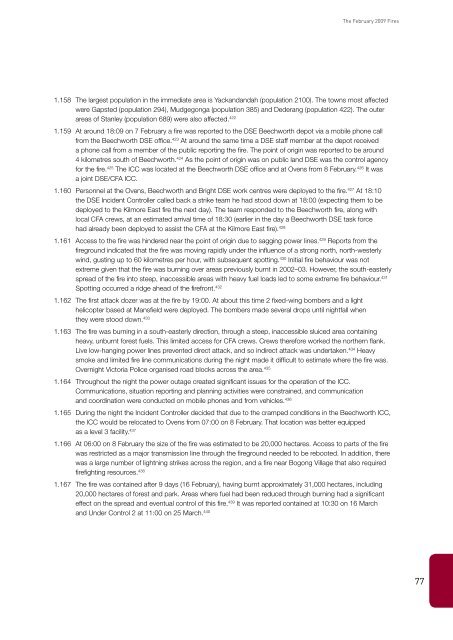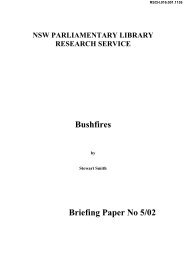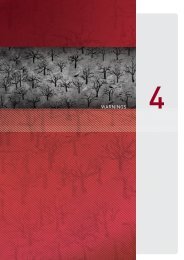the february 2009 fires - 2009 Victorian Bushfires Royal Commission
the february 2009 fires - 2009 Victorian Bushfires Royal Commission
the february 2009 fires - 2009 Victorian Bushfires Royal Commission
Create successful ePaper yourself
Turn your PDF publications into a flip-book with our unique Google optimized e-Paper software.
The February <strong>2009</strong> Fires<br />
1.158 The largest population in <strong>the</strong> immediate area is Yackandandah (population 2100). The towns most affected<br />
were Gapsted (population 294), Mudgegonga (population 385) and Dederang (population 422). The outer<br />
areas of Stanley (population 689) were also affected. 422<br />
1.159 At around 18:09 on 7 February a fire was reported to <strong>the</strong> DSE Beechworth depot via a mobile phone call<br />
from <strong>the</strong> Beechworth DSE office. 423 At around <strong>the</strong> same time a DSE staff member at <strong>the</strong> depot received<br />
a phone call from a member of <strong>the</strong> public reporting <strong>the</strong> fire. The point of origin was reported to be around<br />
4 kilometres south of Beechworth. 424 As <strong>the</strong> point of origin was on public land DSE was <strong>the</strong> control agency<br />
for <strong>the</strong> fire. 425 The ICC was located at <strong>the</strong> Beechworth DSE office and at Ovens from 8 February. 426 It was<br />
a joint DSE/CFA ICC.<br />
427<br />
1.160 Personnel at <strong>the</strong> Ovens, Beechworth and Bright DSE work centres were deployed to <strong>the</strong> fire. At 18:10<br />
<strong>the</strong> DSE Incident Controller called back a strike team he had stood down at 18:00 (expecting <strong>the</strong>m to be<br />
deployed to <strong>the</strong> Kilmore East fire <strong>the</strong> next day). The team responded to <strong>the</strong> Beechworth fire, along with<br />
local CFA crews, at an estimated arrival time of 18:30 (earlier in <strong>the</strong> day a Beechworth DSE task force<br />
had already been deployed to assist <strong>the</strong> CFA at <strong>the</strong> Kilmore East fire). 428<br />
429<br />
1.161 Access to <strong>the</strong> fire was hindered near <strong>the</strong> point of origin due to sagging power lines. Reports from <strong>the</strong><br />
fireground indicated that <strong>the</strong> fire was moving rapidly under <strong>the</strong> influence of a strong north, north-westerly<br />
wind, gusting up to 60 kilometres per hour, with subsequent spotting. 430 Initial fire behaviour was not<br />
extreme given that <strong>the</strong> fire was burning over areas previously burnt in 2002–03. However, <strong>the</strong> south-easterly<br />
spread of <strong>the</strong> fire into steep, inaccessible areas with heavy fuel loads led to some extreme fire behaviour. 431<br />
Spotting occurred a ridge ahead of <strong>the</strong> firefront. 432<br />
1.162 The first attack dozer was at <strong>the</strong> fire by 19:00. At about this time 2 fixed-wing bombers and a light<br />
helicopter based at Mansfield were deployed. The bombers made several drops until nightfall when<br />
<strong>the</strong>y were stood down. 433<br />
1.163 The fire was burning in a south-easterly direction, through a steep, inaccessible sluiced area containing<br />
heavy, unburnt forest fuels. This limited access for CFA crews. Crews <strong>the</strong>refore worked <strong>the</strong> nor<strong>the</strong>rn flank.<br />
Live low-hanging power lines prevented direct attack, and so indirect attack was undertaken. 434 Heavy<br />
smoke and limited fire line communications during <strong>the</strong> night made it difficult to estimate where <strong>the</strong> fire was.<br />
Overnight Victoria Police organised road blocks across <strong>the</strong> area. 435<br />
1.164 Throughout <strong>the</strong> night <strong>the</strong> power outage created significant issues for <strong>the</strong> operation of <strong>the</strong> ICC.<br />
Communications, situation reporting and planning activities were constrained, and communication<br />
and coordination were conducted on mobile phones and from vehicles. 436<br />
1.165 During <strong>the</strong> night <strong>the</strong> Incident Controller decided that due to <strong>the</strong> cramped conditions in <strong>the</strong> Beechworth ICC,<br />
<strong>the</strong> ICC would be relocated to Ovens from 07:00 on 8 February. That location was better equipped<br />
as a level 3 facility. 437<br />
1.166 At 06:00 on 8 February <strong>the</strong> size of <strong>the</strong> fire was estimated to be 20,000 hectares. Access to parts of <strong>the</strong> fire<br />
was restricted as a major transmission line through <strong>the</strong> fireground needed to be rebooted. In addition, <strong>the</strong>re<br />
was a large number of lightning strikes across <strong>the</strong> region, and a fire near Bogong Village that also required<br />
firefighting resources. 438<br />
1.167 The fire was contained after 9 days (16 February), having burnt approximately 31,000 hectares, including<br />
20,000 hectares of forest and park. Areas where fuel had been reduced through burning had a significant<br />
effect on <strong>the</strong> spread and eventual control of this fire. 439 It was reported contained at 10:30 on 16 March<br />
and Under Control 2 at 11:00 on 25 March. 440<br />
77
















